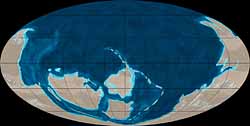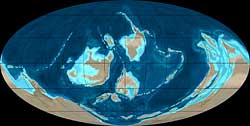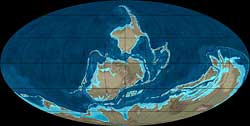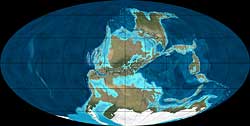The Paleozoic Era

|
|
Global paleogeographic reconstruction of the Earth in the Early Cambrian period 540 million years ago.
(Courtesy Dr. Ron Blakey) |

|
| Global paleogeographic reconstruction of the Earth in the Late Ordovician period 450 million years ago. (Courtesy Dr. Ron Blakey) |

|
| Global paleogeographic reconstruction of the Earth in the Early Devonian period 400 million years ago. (Courtesy Dr. Ron Blakey) |

|
| Global paleogeographic reconstruction of the Earth in the Pennsylvanian period 300 million years ago. (Courtesy Dr. Ron Blakey) |
The Paleozoic Era, meaning "ancient life" is the first of three eras that form a part of the Phanerozoic Eon, the other two periods being the Mesozoic and the Cenozoic. The Mesozoic is the age of the Dinosaurs and the Cenozoic is the era in which we now live. The Paleozoic Era spanned a longer period of time, from approximately 542 Ma to 251 Ma. Just as the Mesozoic is divided into periods (Triassic, Jurassic, and Cretaceous), the Paleozoic Era is also divided. It contains six different periods which are:
| Cambrian (542-488 Ma) |
| Ordovician (488-444 Ma) |
| Silurian (444-416 Ma) |
| Devonian (416-359 Ma) |
| Carboniferous (359-299 Ma) |
| Permian (299-251 Ma) |
The Paleozoic Era is bracketed by two major events in earth's history. It began with an unexplained explosion in animal life and ended with the world's largest mass-extinction known to man. The causes of these great events are currently unknown and under debate.
Tectonics
The tectonic activity during the Paleozoic era is similar to the way it has always behaved but were we to see what the earth looked like at the time, the continents would look almost completely alien to the way they are now. Contrary to popular belief, the continents on earth did not begin as the supercontinent Pangaea. Before Pangaea there were older continents. At the beginning of the Paleozoic the continents were massed in another supercontinent called Pannotia. This was at the end of a global ice age. As the era progressed the supercontinent split into several smaller continents, still unrecognizable from the continents we know today. Near the end of the Paleozoic era the continents began to regroup as the supercontinent Pangaea. The collisions as the supercontinent was formed were strong enough to form mountain chains higher than the Himalayas. Among these mountain chains were the Appalachian mountains located on the east coast of North America, formed from a collision with what would become Africa.
Environment
Plant life took a little while to take off, but in the Carboniferous period the foliage thrived. The remains of the Carboniferous plant life are what form most of today's modern coal. However, this abundance in foliage declined by the Permian period and continued past the Paleozoic era into the Triassic period. At the start of the Paleozoic era the climate was moderate and shifting between stable and unstable. However, near the mid Paleozoic the climate stabilized to support all manner of land-roaming life. Near the end of the Paleozoic era the oxygen increased and carbon dioxide levels reached an all-time low causing severe ice ages in the Carboniferous period. Later, the continent Pangaea formed, creating a large surface area which caused extreme temperatures. This climate deterioration near the end of the Paleozoic may have been the cause of the mass-extinction event that marked the end of the Paleozoic era.
Animal Life
The beginning of the Paleozoic era is marked by a sudden explosion of invertebrate animals, over 900 recorded species in the Cambrian period. It was only a few million years later that vertebrates appeared during the Ordovician period. The Devonian period showed an uprising in fish and other marine life. By the end of the Paleozoic era evolution had caused complex land and marine animals to exist. Much of the land was dominated by large reptiles, the early ancestors of the dinosaurs. However, the event that marked the end of the Paleozoic period was the massive extinction that wiped out nearly 96% of all marine life and 70% of land animals. Only a few species survived including some reptiles. Moving into the Mesozoic era and with the competition nearly eliminated those reptiles would eventually evolve to become the lords of the earth, also known as the Dinosaurs.
| Proterozoic eon |
542 Ma - Phanerozoic eon - Present | |||||||||||
|---|---|---|---|---|---|---|---|---|---|---|---|---|
| 542 Ma - Paleozoic era - 251 Ma | 251 Ma - Mesozoic era - 65 Ma | 65 Ma - Cenozoic era - Present | ||||||||||
| Cambrian | Ordovician | Silurian | Devonian | Carboniferous | Permian | Triassic | Jurassic | Cretaceous | Paleogene | Neogene | Quaternary | |